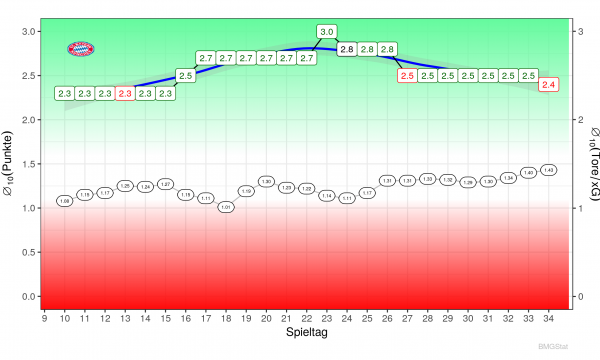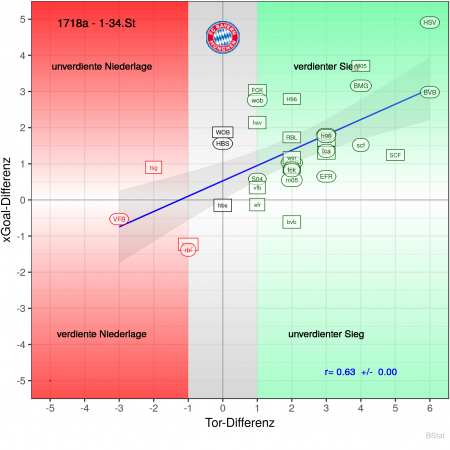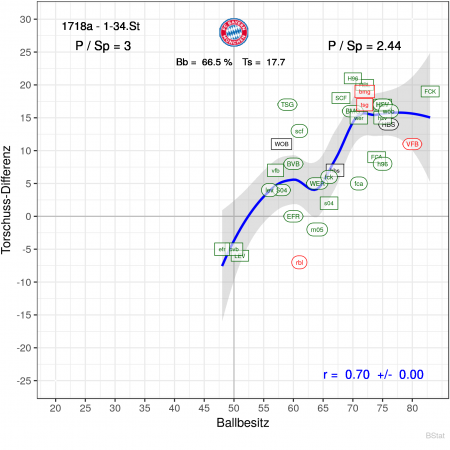Roundup: Season End Statistics
In the 2017/18 season, the Munich-based team collected a total of 84 points, which represents the fourth-best Bundesliga season of all time. For the fifth time in six years, the record champion surpassed the “historic mark” of 81 points predicted by Jürgen Klopp in 2012. This is an achievement that cannot be overestimated and may even have to put a spoke in the wheel of the weakening competition.
The goal ratio of +64 also equalled the Reds’ fourth-best season, with the 28 goals conceded being the highest score since the 2010/11 season – 40 goals scored at the time. However, the new champion scored more than 90 goals for the sixth time with 92 of their own goals.
For further analysis we want to go into more detail and use the statistics of the great Twitter Michael Karbach, who puts them on his Website also for all other clubs.
Form Graph at Master Level
The first statistic to be presented here is a form graph. To create these, a moving average of the points from the last ten games is formed. A value greater than two points from ten games is good and in most cases sufficient for the direct qualification to the Champions League. This area is displayed in green.

(Source: BStat)
Since the last ten matchdays are always considered, the statistics only make sense after the tenth matchday, which is why only games are listed under Jupp Heynckes. For a better overview, victories in green, draws in black and defeats in red are listed.
From the diagram you can see that FC Bayern under Heynckes dominated the Bundesliga almost at will. For a phase of ten games, from the 14th to 23rd matchday, all matches could be won and only a draw against Berlin in late February broke this series.
The performance and consistency of the Munich-based team becomes particularly obvious when you look at the form graphs of the competition. Only Schalke could keep an average of at least 2.3 points/game for more than two days of play. Only nine teams, i.e. just half of the league, managed to score an average of 2.0 points/game or more for ten games.
With deserved victories to the title
If you win the championship by 21 points, you don’t have to argue whether you deserved to win the title. However, we want to look at the figures.
The difference between the goal difference and the expected goals difference is considered as statistics for this term, which is difficult to grasp objectively. An expected goal (xG) calculates the probability with which a goal will result in a goal, using the position of the goal and the number of opponents up to the goal as criteria.

(Source. BStat)
In the graphic, the two goal differences – real and expected – are now plotted against each other. Achieved victories are shown on the right and in green, while the “degree of merit” decreases from top to bottom. This divides the display into four areas, e.g. a deserved victory at the top right. For a better overview, home matches in upper and away matches are marked in lower case. In addition, first round matches are surrounded by square corners and second round matches by rounded corners.
In only six games, the xG showed a negative goal difference for the Munich team. They lost three of them, including their last home match against Stuttgart, won two and once played a draw. In fact, the xG difference was not even less than two goals, which was a sign of tight games decided by trifles.
In the first defeat of the season against Hoffenheim, the model even sees an undeserved defeat, since the xG difference spoke for a Bayern victory. However, the position error before the 1-0 leading goal of the Hoffenheimers does not matter.
All in all, the statistics now show three deserved and one undeserved defeat for the Munich team. The two undeserved victories contrast with a total of 25 deserved victories, although the three draws were unfortunate, at least according to statistics. The last Ancelotti game with the 2-2 draw against Wolfsburg after a 2-0 lead is particularly noteworthy. Ulreich’s error is also not statistically recorded here.
Many finishes and even more ball possession
Finally, I would like to briefly mention the Munich offensive. For this purpose, the number of shots on goal is compared directly with the opponent’s own ball possession share. Over the entire season, the record champion had an average of 66.5% possession of the ball and shot 17.7 times per game at the opponent’s goal. Both are top scores in the Bundesliga.

(Source: BStat)
These statistics also underline how dominant the team from the Isar is in the Bundesliga. Only two opponents, namely Frankfurt and Dortmund, managed more ball possession phases than the Munich team in one game. This result may be doubted due to the character of the team’ s first game against Eintracht. Likewise, only five teams were able to win the scoring duel with Bayern.
The correlation between the possession of the ball and goals, which is indicated by the blue line, is striking. This is less clear with other teams, although in this case, too, there is no straight line.
Furthermore, it becomes obvious that a pure plus of shots on goal is no guarantee for a victory. The defeats in Hoffenheim and Gladbach, for example, gave them a better chance than victories over Schalke or Augsburg. The same conclusion can also be drawn for the share of ball possession.
Links of the week
Disguised women sneak into Iranian football match | BBC
Bayern chief indicted by U.S. jury | Stephan Uersfeld | ESPN
Niko Kovac Total Football Analysis | Total Football Analysis
Average transfer value per club: Manchester City heads the table | CIES Football Observatory









